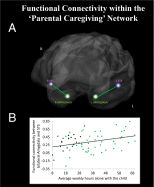Father's brain is sensitive to childcare experiences
- PMID: 24912146
- PMCID: PMC4103311
- DOI: 10.1073/pnas.1402569111
Father's brain is sensitive to childcare experiences
Abstract
Although contemporary socio-cultural changes dramatically increased fathers' involvement in childrearing, little is known about the brain basis of human fatherhood, its comparability with the maternal brain, and its sensitivity to caregiving experiences. We measured parental brain response to infant stimuli using functional MRI, oxytocin, and parenting behavior in three groups of parents (n = 89) raising their firstborn infant: heterosexual primary-caregiving mothers (PC-Mothers), heterosexual secondary-caregiving fathers (SC-Fathers), and primary-caregiving homosexual fathers (PC-Fathers) rearing infants without maternal involvement. Results revealed that parenting implemented a global "parental caregiving" neural network, mainly consistent across parents, which integrated functioning of two systems: the emotional processing network including subcortical and paralimbic structures associated with vigilance, salience, reward, and motivation, and mentalizing network involving frontopolar-medial-prefrontal and temporo-parietal circuits implicated in social understanding and cognitive empathy. These networks work in concert to imbue infant care with emotional salience, attune with the infant state, and plan adequate parenting. PC-Mothers showed greater activation in emotion processing structures, correlated with oxytocin and parent-infant synchrony, whereas SC-Fathers displayed greater activation in cortical circuits, associated with oxytocin and parenting. PC-Fathers exhibited high amygdala activation similar to PC-Mothers, alongside high activation of superior temporal sulcus (STS) comparable to SC-Fathers, and functional connectivity between amygdala and STS. Among all fathers, time spent in direct childcare was linked with the degree of amygdala-STS connectivity. Findings underscore the common neural basis of maternal and paternal care, chart brain-hormone-behavior pathways that support parenthood, and specify mechanisms of brain malleability with caregiving experiences in human fathers.
Keywords: alloparental care; mothering; parent–infant interaction; social brain; transition to parenthood.
Conflict of interest statement
The authors declare no conflict of interest.
Figures





Comment in
-
Flexibility of the father's brain.Proc Natl Acad Sci U S A. 2014 Jul 8;111(27):9671-2. doi: 10.1073/pnas.1408807111. Epub 2014 Jun 30. Proc Natl Acad Sci U S A. 2014. PMID: 24982185 Free PMC article. No abstract available.
References
-
- Geary DC. Evolution and proximate expression of human paternal investment. Psychol Bull. 2000;126(1):55–77. - PubMed
-
- Hrdy SB. Mother Nature: A History of Mothers, Infants, and Natural Selection. New York: Pantheon Books; 1999. - PubMed
-
- Lamb ME, Lewis C. In: The Role of the Father in Child Development. 5th Ed. Lamb ME, editor. Hoboken, NJ: Wiley; 2010.
-
- Wynne-Edwards KE. Hormonal changes in mammalian fathers. Horm Behav. 2001;40(2):139–145. - PubMed
Publication types
MeSH terms
LinkOut - more resources
Full Text Sources
Other Literature Sources
Medical

